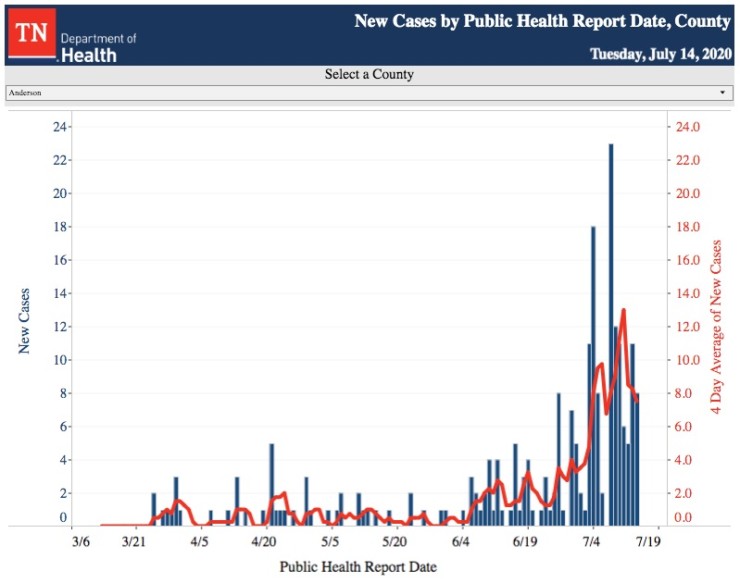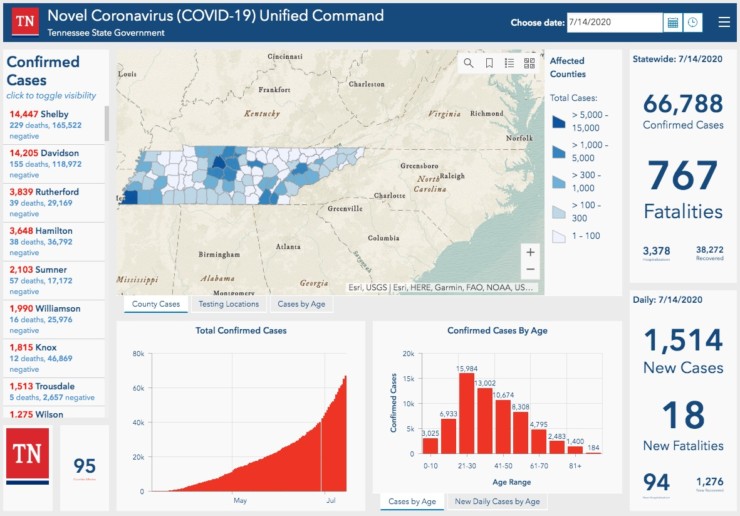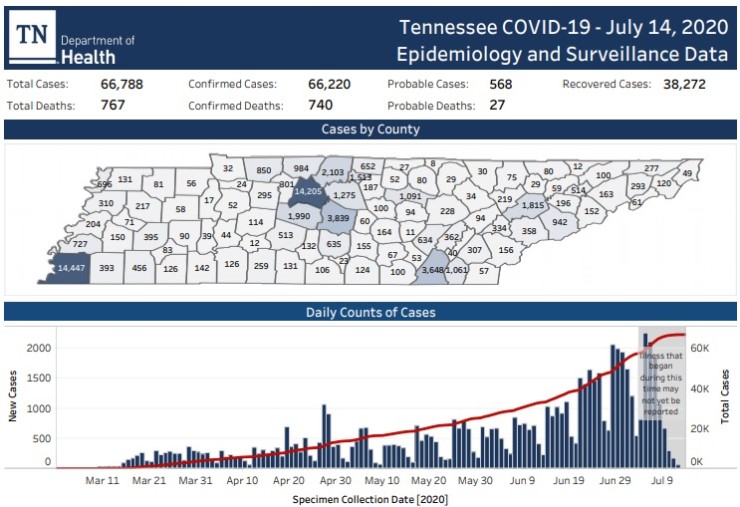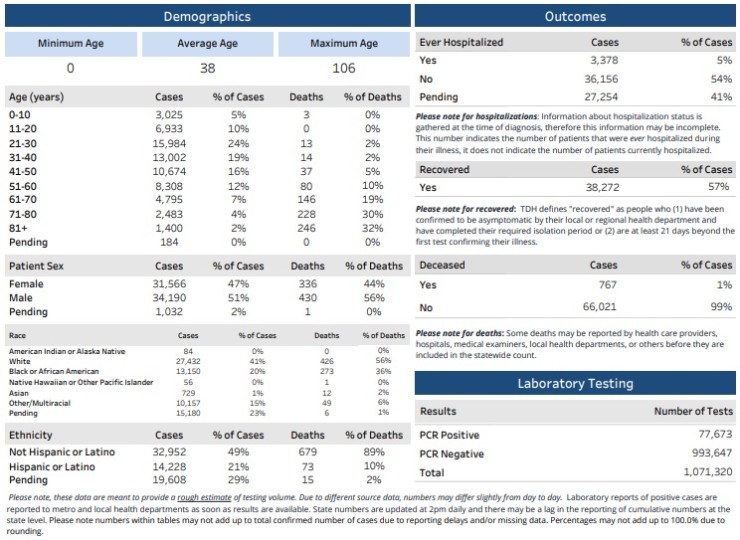
Anderson County now has more than 200 total COVID-19 cases, and more than 100 are active.
The county reported 219 total COVID-19 cases and 101 active cases on Tuesday. Active cases are total cases minus recoveries and deaths.
The number of total cases has more than doubled since July 2, less than two weeks ago, and the number of active cases has about tripled since then.
Total cases measure how many residents have been infected. Active cases measure patients who have survived and might still have symptoms or are within 21 days of their first diagnosis.
The hospitalizations in Anderson County have not increased as fast as the new cases. On July 2, there were 10 total hospitalizations in Anderson County due to COVID-19. On Tuesday, the Tennessee Department of Health reported there have been 14 total hospitalizations in Anderson County. It’s not clear how many of those patients remain in the hospital.
The number of deaths has remained unchanged since June 4, when the second death due to COVID-19 was reported in Anderson County.
The county averaged 10.86 new cases per day during the past seven days. That’s about double what it was a week earlier. During the previous week, there was an average of 5.85 new cases per day in the county.
The doubling of the average number of new cases per day this week occurred even as the average number of new tests per day dropped about 9 percent. That means that, on average, more people have tested positive for COVID-19 in Anderson County each day this past week even as fewer people have been tested.
It wasn’t immediately clear why fewer people have been tested in Anderson County in the past week.
There haven’t been any peaks since 23 new cases were reported on Wednesday. That was a record for Anderson County, which has about 77,000 residents.
While the average number of new cases per day in the county was about double this week compared to last week, it was even higher when compared to two weeks ago: about three times as high.
The daily positivity rate in Anderson County hit 20 percent on Tuesday. That’s the first time since Oak Ridge Today started tracking the number that the positivity rate has been that high. But it’s also based on a small number of tests—40 tests, with eight positive results.
It’s the fourth time this month that the daily positivity rate has been over 10 percent. Three of those have been in the past week.
The overall positivity rate in Anderson County, including all cases and all tests, continues to slowly climb. It was up to 2.3 percent on Tuesday, a 1 percent increase from 1.3 percent in late June. That means that, overall, a higher percentage of people are testing positive for COVID-19 out of those who are tested.
The case doubling time in Anderson County has dropped to 12 days. It’s down from 23 days on July 2. That means the case count is increasing faster.
Here are some comparisons between July 2, when case growth started to accelerate, and July 14 in Anderson County:
July 2
- 105 total cases
- 32 active cases
- 2 deaths
- 10 total hospitalizations
- 71 recovered
- Case doubling time: About 23 days
July 14
- 219 total cases
- 101 active cases
- 2 deaths
- 14 total hospitalizations
- 116 recovered
- Case doubling time: About 12 days
Here are the seven-day averages for new cases and tests during the past three weeks:
June 24-30
- Average number of new cases per day: 3.43
- Average number of new tests per day: 96.7
July 1-7
- Average number of new cases per day: 5.86
- Average number of new tests per day: 163.4
July 8-14
- Average number of new cases per day: 10.86
- Average number of new tests per day: 149
Outside of Anderson County, the state of Tennessee reported 66,788 cases of COVID-19 on Tuesday. Tennessee has about 6.8 million residents, so that’s almost 1 percent of the state’s residents.
The Tennessee Department of Health reported the largest one-day statewide increase in new cases on Monday: 3,314.
There were about half as many new cases reported Tuesday: 1,514.
The state’s previous daily record was 2,472 new cases on Wednesday.
Lisa Piercey, commissioner of the Tennessee Department of Health, said the state focuses more on trends than on day-to-day variations, and the reporting can vary depending upon the day of the week. For example, on Sunday, the day before Monday’s record high, there were significantly fewer new cases reported: 954.

During a press conference Tuesday, Piercey said there are about 870 patients currently hospitalized with COIVD-19 in Tennessee. That’s more than double the roughly 400 patients hospitalized around June 19 and 20.
Piercey said no hospitals in the state are currently in crisis mode, but systems in Memphis, Nashville, and several other metropolitan areas are starting to feel some strain.
The rate curves for intensive care and ventilators are not as steep as the curve for hospitalizations, Piercey said. That’s due to things that doctors and health care workers have learned, she said. Normally, with respiratory problems, health care workers would want to put someone on a ventilator, Piercey said. But she said COVID-19 patients tend to do better if they are kept off ventilators.
A medication called remdesivir is used for the “sickest of the sick,” and it’s a “big game-changer,” Piercey said.
She said the state’s positivity rate, which was 8.5 percent on Tuesday, has trended up in the past 30 days, but it appears to be stable for now, which is encouraging. State officials would like to see that positivity rate come down, Piercey said.
The Tennessee Department of Health reported a total of 767 deaths due to COVID-19 in the state since the first case was diagnosed Wednesday, March 4.
There have been 3,378 hospitalizations and 38,272 recoveries, according to the state health department.
There have been more than one million COVID-19 tests in Tennessee.
There are now 27,749 active cases across the state.

The death rate in Tennessee has slowly dropped to 1.1 percent while the hospitalization rate has fallen faster to 5.1 percent.
But the statewide recovery rate also continues to fall. It’s now down to 57.3 percent. Not long ago, it was about 66 percent.
The average age of patients has also dropped again. It’s now 38.
The seven-day average of new cases per day in Tennessee has increased significantly from 1,029 on June 30 to 1,896 on Tuesday.
The seven-average of new deaths per day had remained stable at about 8.7 to 8.8 between June 30 and July 7. But it increased to 14.57 on Tuesday.
The case doubling time in Tennessee continues to decrease. It’s now down to 26 days.
State, county statistics
The highest number of cases in the state is in Shelby County, which includes Memphis in West Tennessee. The case count there was 14,447 on Tuesday. There have been 229 deaths in Shelby County.
In Davidson County, 14,205 cases have been reported, and 155 deaths have been reported. Davidson County includes Nashville in Middle Tennessee.
Other counties with case counts of more than 1,000 include:
- Rutherford (Nashville area), with 3,839 cases and 39 deaths;
- Hamilton (Chattanooga area), with 3,648 cases and 38 deaths;
- Sumner (Nashville area), with 2,103 cases and 57 deaths;
- Williamson (Nashville area), with 1,990 cases and 16 deaths;
- Knox (Knoxville area), with 1,815 cases (up almost 350 since Thursday) and 12 deaths (up three from Thursday);
- Trousdale (Turner Trousdale Correctional Center), with 1,513 cases and five deaths;
- Wilson (Nashville area), with 1,275 cases and 17 deaths;
- Putnam (Cookeville area), with 1,091 cases and 7 deaths; and
- Bradley (Cleveland area, near Chattanooga), with 1,061 cases and 5 deaths.
Another East Tennessee county, Sevier County, a tourist destination, has seen its case count climb significantly. Sevier County now has 942 cases and four deaths. That’s up about 80 cases since Thursday, with one more death.
Here is COVID-19 case information about other counties surrounding Anderson County:
- Loudon County has reported 334 cases, up 26 cases since Thursday, and its second death.
- Roane County has reported 94 cases, up 19 cases since Thursday, and no deaths.
- Campbell County has reported 75 cases, up 10 cases since Thursday, and one death.
- Morgan County has reported 34 cases, up 5 cases since Thursday, and one death.
- Union County has reported 29 cases, up 9 cases since Thursday, and no deaths.
- Scott County has reported 22 cases, up 8 cases since Thursday, and no deaths.
COVID-19 is a new, contagious respiratory illness that can be deadly. It can cause a range of health issues that can last weeks or months, including fevers, body aches, fatigue, coughing, and breathing problems, among other reported symptoms. The long-term effects remain unknown.
It can be spread by respiratory droplets from coughing, sneezing, talking, and singing. There is also debate about whether it might be spread by airborne transmission.

The disease appears to be especially deadly to patients who are 61 years old and older, according to data from the Tennessee Department of Health. In Tennessee, the number of deaths starts rising in the 41-50 age group, with 37 or more deaths in those age groups, and it continues to climb in older age groups. There have been between 146 and 246 deaths in the three oldest age groups: 61-70, 71-80, and 81 and older.
The largest number of cases continues to be among patients who are 21 to 30 years old, followed by patients who are 31 to 40, and then patients who are 41 to 50.
The average age of patients has dropped in the past few months. It’s now at about 38.
While some people report no symptoms or mild symptoms, others become seriously ill from COVID-19, sometimes for weeks, and the effects can sometimes last for months. Others are admitted to the hospital, and some patients end up in intensive care and on ventilators.
To help prevent the virus from spreading, officials have repeatedly recommended that residents wear a face mask or covering when they are out of the house and around others, maintain a distance of at least six feet from other people when possible, and wash their hands frequently.





Leave a Reply